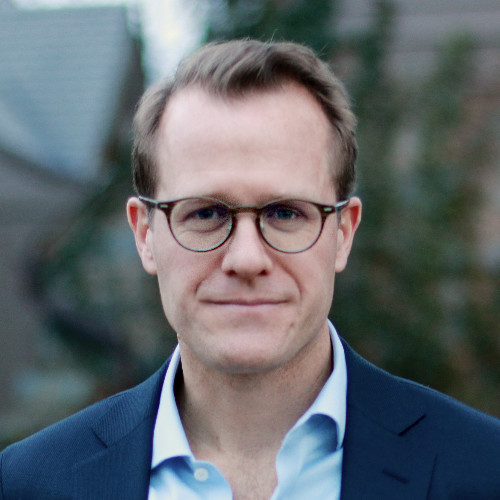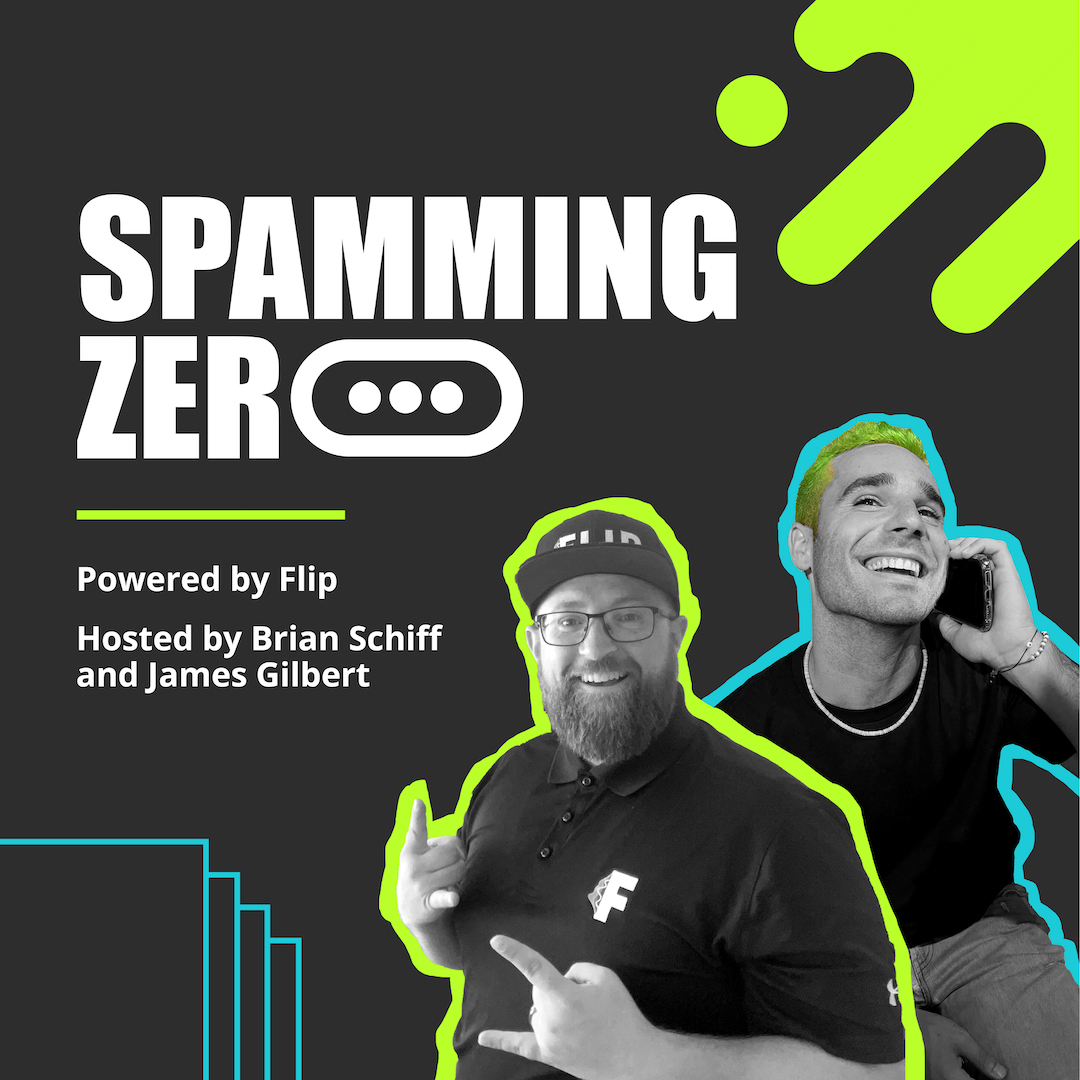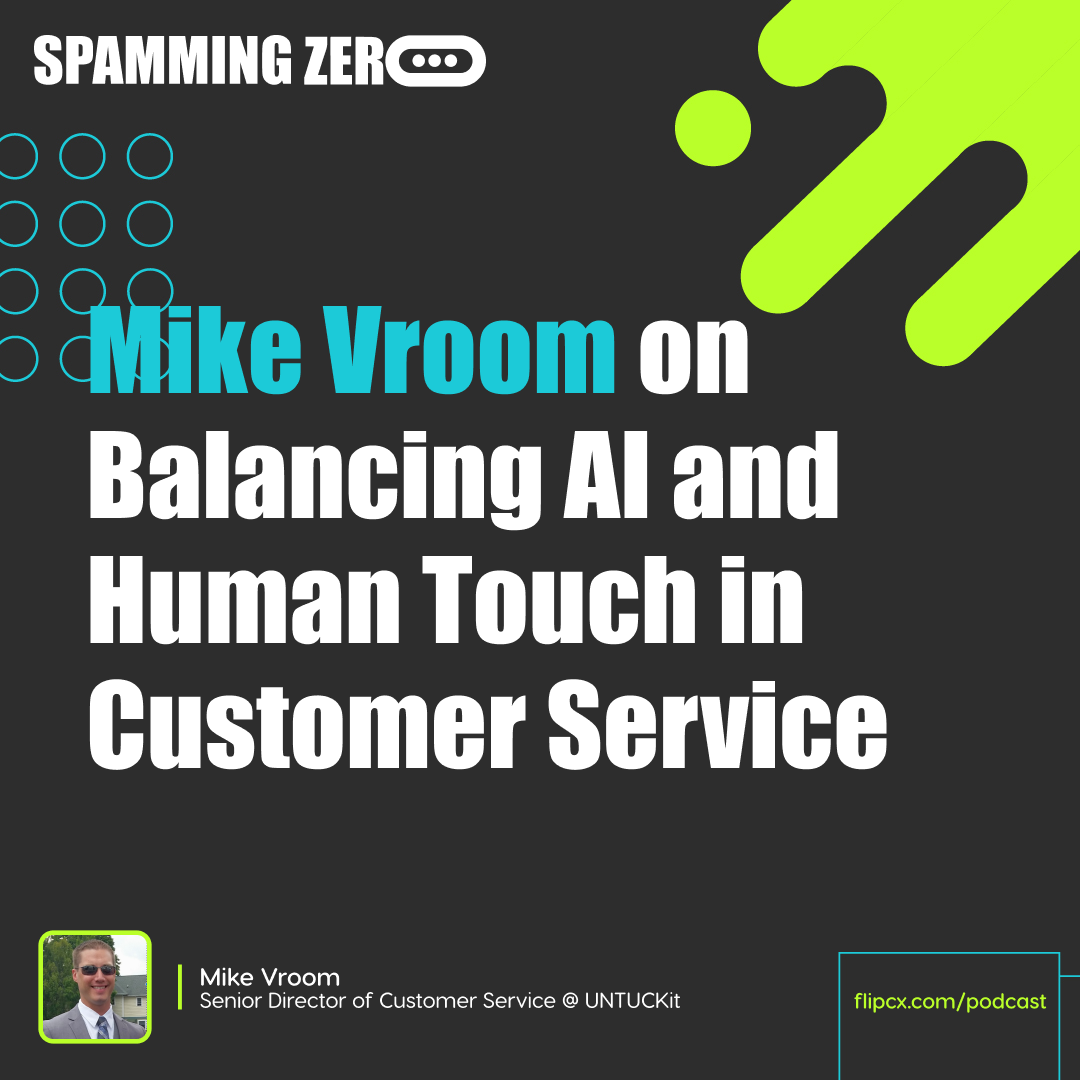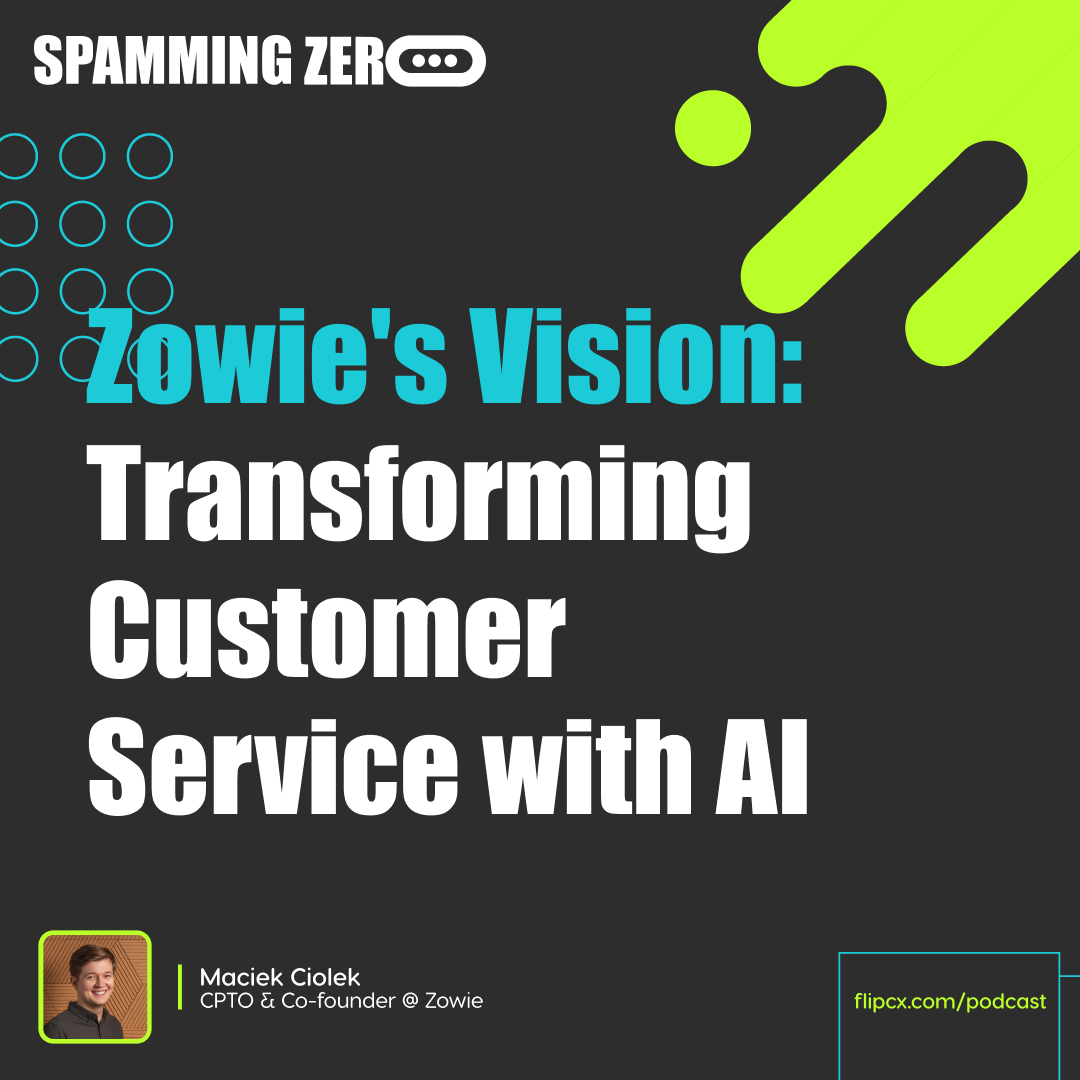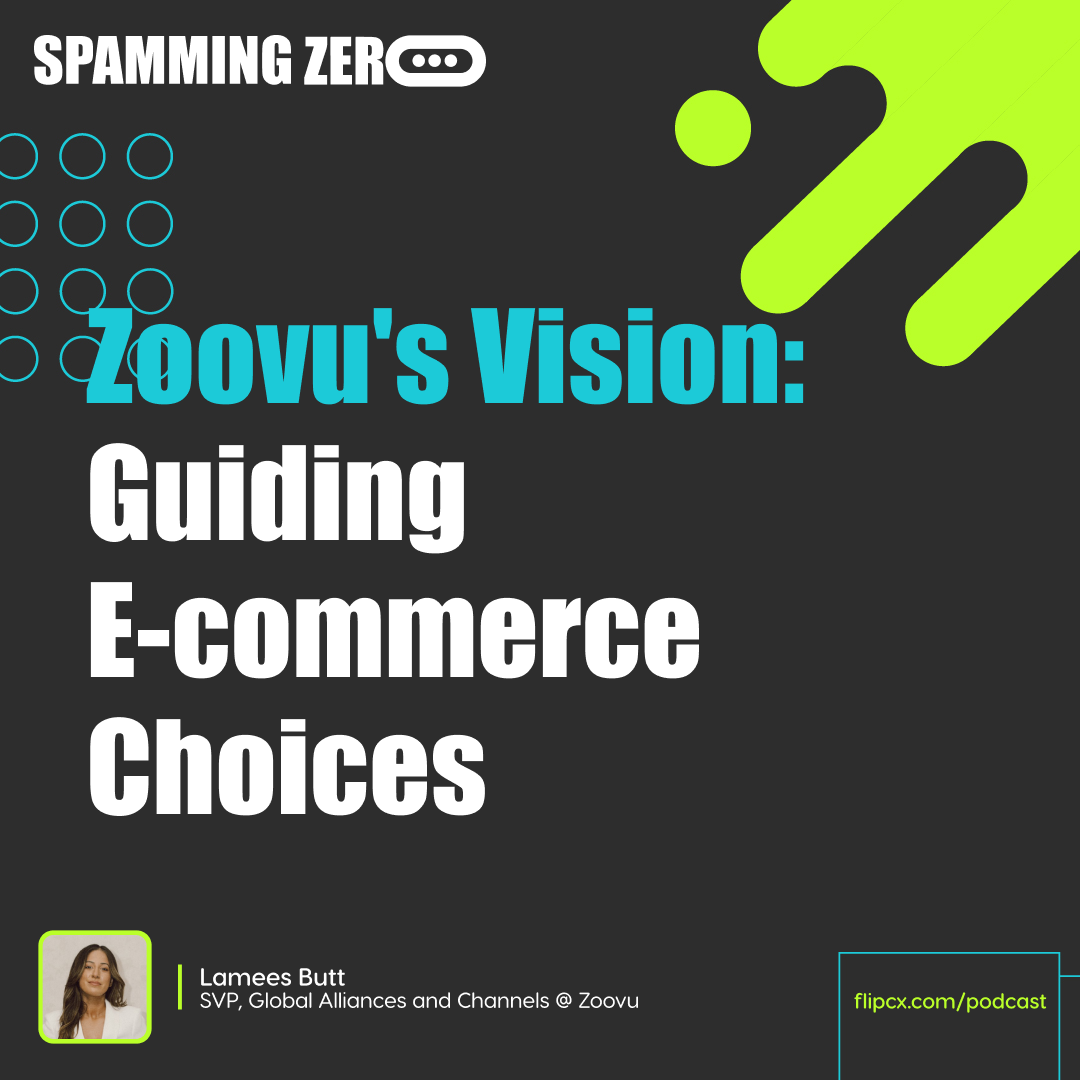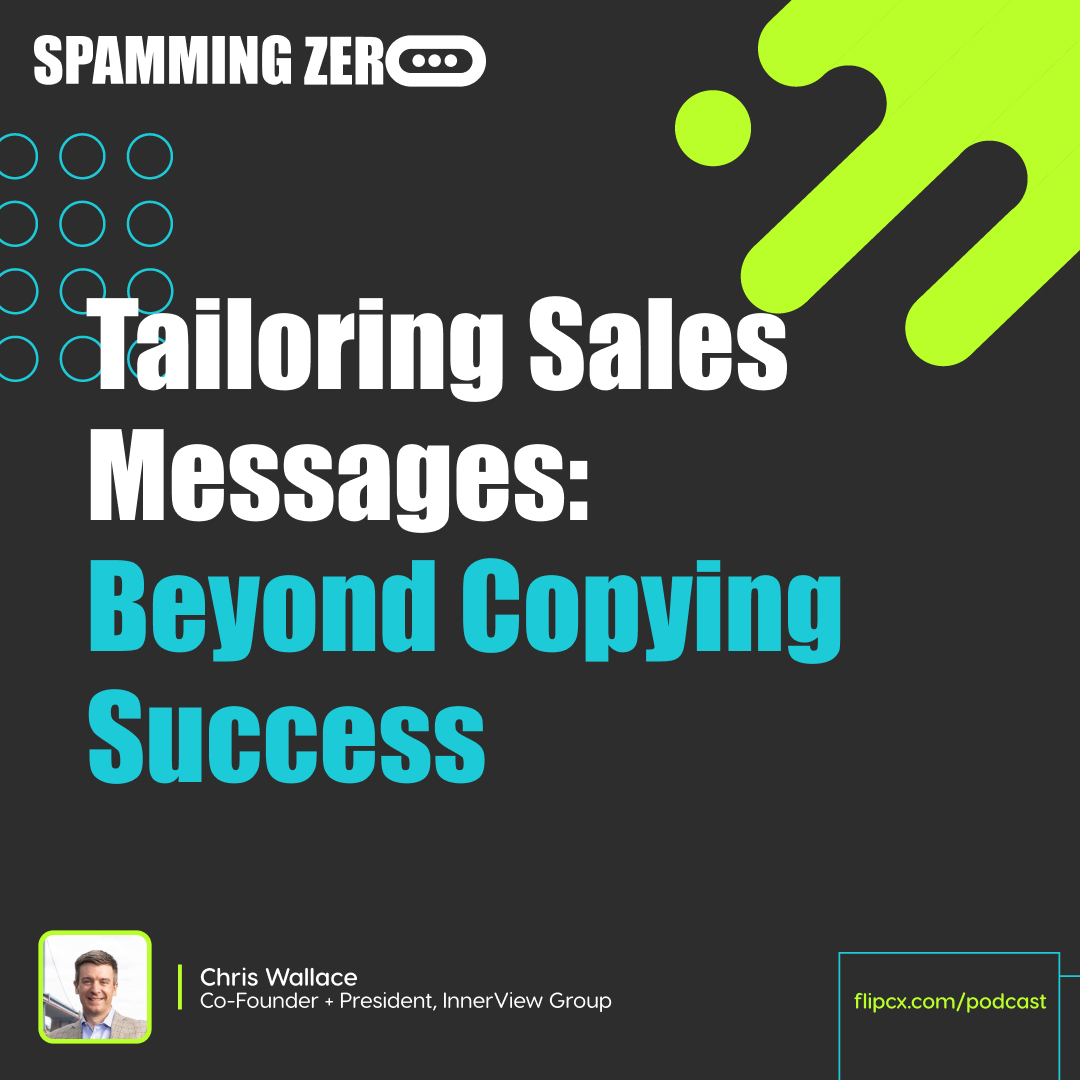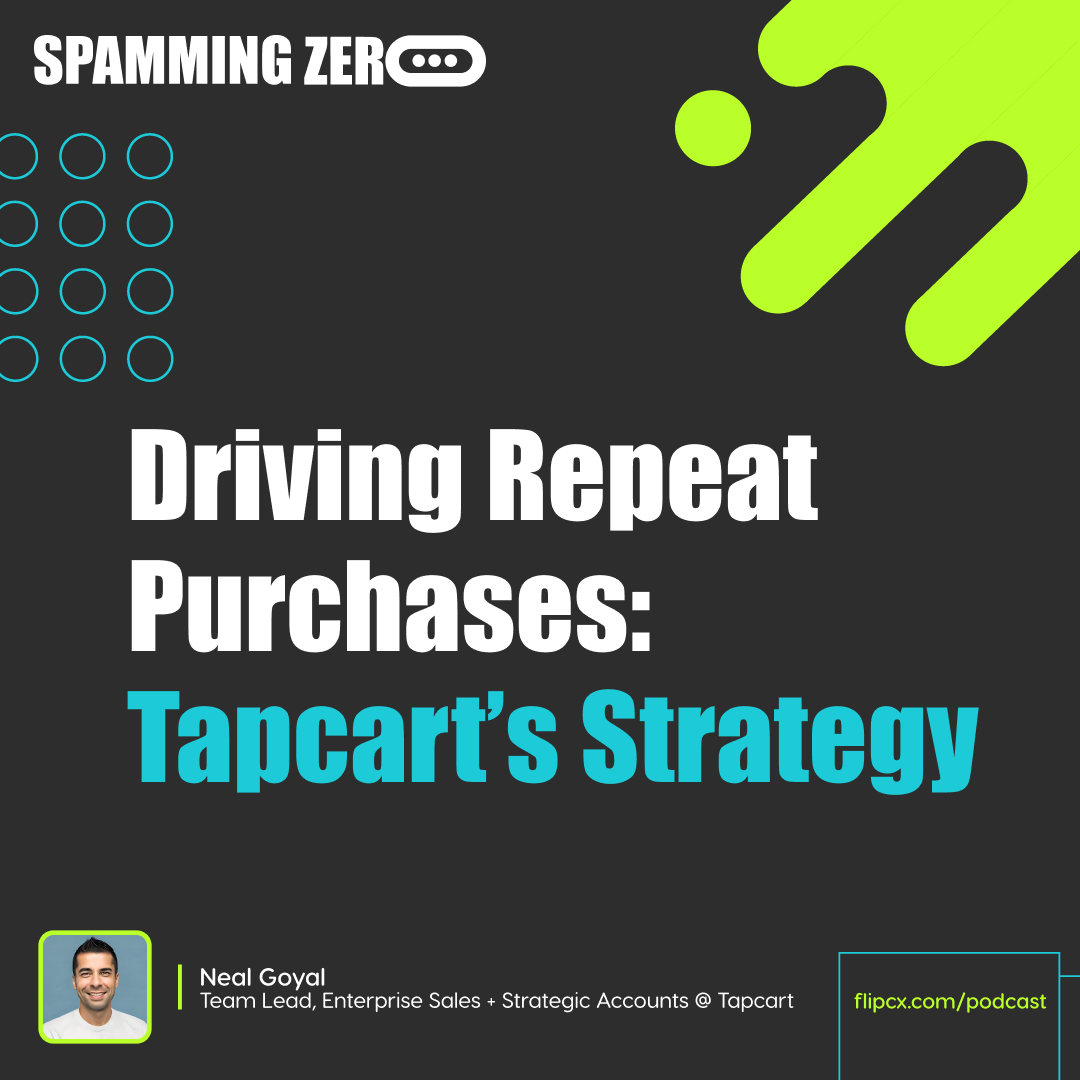Episode 11: How To (Nicely) Jolt Potential Customers Out Of Indecision
- 0.5
- 1
- 1.25
- 1.5
- 1.75
- 2
James: Ladies and gentlemen, boys and girls, welcome to Spamming Zero. I am so excited about today. Today we're joined by one of the most iconic figures in the customer experience world, Matt Dixon, founder of, partner of DCM Insights. He is the co- author of Effortless Experience and many other books. Yeah, that's right. The fourth book is coming in September. Man, I can't even imagine. We're going to talk about that a little bit. DCM Insights is a boutique advisory firm, leveraging data to improve their sales and customer experience. If you're interested in that, reach out to Matt, we'll provide the details in the show notes so that you can have those. Welcome to the show. I'm James.
Brian: And I'm Brian.
James: And this is Spamming Zero.
Matt Dixon: James, Brian, it's great to be here. These guys gave me a reprieve. Last time I was just overcoming my second bout with COVID and I couldn't make it. I wanted to make it, but I left you guys hanging. So I appreciate the invite back to make up for it.
James: I'm glad you're on the up and up and in good spirits. Matt, you speak all over the world. You're a high level keynote speaker for many, many different people. So I would like for you to just give us... Let's let the audience get to know you on a personal level that they might not.
Matt Dixon: Yeah.
James: So let's start with just some random questions. What's a guilty pleasure that you have?
Matt Dixon: Oh gosh, guilty? So I'm a craft beer fan. So I've got a lot of LinkedIn followers, and I don't have as many followers on Untapped, which is a beer rating app you guys may be familiar with. But that's probably my guilty pleasure is I really like a good IPA. It's a little bit like drinking a loaf of bread so it's probably not the best thing in the world for you, but I love beer tasting. I'm fascinated by micro breweries. So kind of my guilty pleasure.
Brian: Good for the soul, if not for the body.
Matt Dixon: There you go.
Brian: So you're out in the wild every day speaking with different companies. There's a lot happening at a macro level right now. I'm curious, what are the biggest things that you're seeing, as you talk to the leaders in these different companies right now?
Matt Dixon: So, as I think as your listeners may know and as you guys know, I've kind of in my career I've worn two hats. I focused on both customer experience and customer service and also on sales effectiveness. That's been my other... So it's funny because people at inaudible are like," Oh, effortless experience, customer effort score," like that's what... But then I show up at another conference... And those people at a customer experience conference are always like," What's the challenger sale? I didn't even know that was the thing?" Then I go to a sales event and they're like," What's a customer effort score? What's the effortless experience? So it's always like I'm toggling between these two things. But I think there's this interesting intersection, Brian, and it's coming up of late over the last couple of years. This funny thing happened in March of 2020 in the sales world, sales went completely virtual overnight. Now, for companies like yours and for fast moving tech companies, sales was happening largely on Zoom or Teams or whatever web conferencing platform anyway. But for large companies, that was a huge shift in the way they did business. And I think there's been this kind of interesting phenomenon that's happened. So companies, they were doing more sales meetings, but I don't know that they were becoming more effective. And they felt like something was missing in those virtual sales interactions. And one of the trends we actually started to track in sales was every year it felt like an increasing percentage of deals, when we talked to sales leaders, were being lost to no decision. What I mean specifically by that, it's not... Salespeople lose, they don't win all their deals. We know that. So imagine the average salesperson converts 25 to 30% of their opportunities. But if you look at the rest of them and you look at the losses specifically, and the average sales person would tell you, they're way more likely to lose to no decision than to a named competitor. And this is something that we've been tracking and it's gotten worse every year over the past three years. And it's the number one thing that I'm talking to company executives right now about. Because in a world where budgets are getting tight, companies have gone from blitzscaling to now trying to be very efficient with their go to market spend and their resource allocation. They're preparing for the coming storm. And there's a lot of handing and nervousness right now. And when people start to dig into the numbers, they realize that anywhere between 40 to 60% of their time, their sales people are taking a customer through the entire sales process. They're eating up massive amounts of their own seller's time, as well as the time of their organization, their subject matter experts, their solutions engineer. They're doing paid pilots, they're doing proof of concept trials. They're doing reference calls. They're doing demos out the wazoo, iterations of proposals, tons of interactions with the client. And this is say nothing of all the client's time and energy they're putting against this. And then to go through that entire process only to do nothing. And so companies look at this and they're like," That was painful when things were good. It's really painful when things start to get kind of tight." And the other problem with indecision and no decision is it's just going to get worse, when the economy starts to take a nose dive. People are going to become much more prone to do nothing. And so when I'm out there talking to companies, I think they're taking a really hard look at their go to market resource allocation. And that's one of the real warts in any sales organization, and sales leaders are like," We've got to do something about this. We've got to lose earlier. We've got to teach our sales people to stop chasing garbage trucks. And we've got to figure out why is it that our customers go through a six month sales process and then don't pull the trigger. Even though they said they wanted to move forward, they do nothing. And how do we teach our sales people, get those customers over the line?" So that's actually what we spent two years studying this problem. It's what the new book is all about, The JOLT Effect, but I think it's kind of this intersection of customer experience and sales effectiveness. Because really what the book is about, is about the sales experience and I think when you get down to it, what leads customers to do nothing is fear of failure. And it's specific things they're worried are going to go wrong and sales people are just not tuned into this stuff. They're not seeing things from the customer's perspective and so they just hammer them with their proof points, their messaging, their success stories, their ROI calculators, their demos, and it just rings hollow for the customer. It doesn't get them comfortable with the decision. Doesn't instill any confidence. And it's very similar to what we wrote about in the Effortless Experience. We all think that it's about delighting customers and giving them free stuff and wowing them at every turn. But it's actually what the customer really wants is for you to make it easy for them. And this is very similar, right? It's a similar story. And so I think what's so interesting is what resonated about the Effortless Experience for CX and service leaders and CMOs and CEOs, is we looked at the customer experience but from the customer perspective, what is it that they're really looking for from the companies they do business with. In this new book, we're doing something very similar, which is we're looking at the sales experience but from the customer's perspective. What are they experiencing as they're going through this? And what is it that leads to these bad outcomes and what do salespeople need to know to be more effective? Yeah. I'll get you inaudible guys. I'll get you a copy for sure.
James: I'm serious, man. This is something that I have been vocally complaining about in social media. Sometimes somewhere on the show we ask people," Oh, tell me about an experience that you dream about." And you know what mine is? That I never have to talk to sales again and I could buy new stuff.
Matt Dixon: I don't think you're alone there.
James: I know these inaudible-
Brian: It's that you can buy the way you want to buy. Sometimes you might want to talk to somebody and then you want to talk to them.
James: True.
Brian: It's just you don't want to be stuffed into their boxes and their frameworks and their processes.
James: See, and that is it, that's the key. There's so many other, I mean, some of these communities with a bunch of other folks that are at similar levels and they're decision makers, they have a P& L, they have a budget, right? For folks that are at that level, just let them buy and don't get in the way and provide, to your point, an effortless experience.
Matt Dixon: So it's really interesting. In the new book, we talk about there's this fascinating story. I don't know if you guys have been tracking this over time, but one of the industries that we find really fascinating, it's something that we write about in the new book. It's something that we used to talk about a lot when I was at CB with some of my research partners there, Brent Adamson, Nick Toman, and some of the team over there. And one of the trends we were tracking over time is this really fascinating, kind of a rise and fall of the travel agency. So this is a really fascinating business story where in the early 2000s, the mom and pop travel agency, that business absolutely disappeared, from the face of the earth. And it was because of the rise of Travelocity and Expedia and orbits and all these, the ability for consumers to book their own travel. It's like," Now, I don't need to go through the middleman, who's going to charge me a service fee to book my plane ticket. If I know where I want to go, I know where I want to stay, I can just book it myself and it's super efficient." But what also happened in the intervening years is that the amount of information available to travelers just exploded. So if memory serves, I think the first post on TripAdvisor was right around the same time. It was'99, 2000, something like that. It was right around that time. And I think they just posted their billionth review or something like that. And so it's funny, because think about today, right? You go to plan a trip, especially if it's some place you've never been before, and you go to trip advisor or you Google like," Hey, I'm planning a honeymoon to Italy," or" I'm planning a trip to Costa Rica or Thailand or whatever," and you've never been before. There is no way in a million years you could get through all that information. And then you start ringing your hands about," This is a lot of money, this a big decision. This is our honeymoon," or it's a really expensive family trip or it's a special occasion. A once in a lifetime trip. I don't want to mess it up. What do I pick? Where do I stay? Where do I go? What should I avoid? What are the dos and don'ts? There are no shortage of opinions. There is so much information that in 10 lifetimes, you could never consume at all. So what do you want in that situation? What you want is a really great travel agent, or as they call themselves today, travel advisors, right? Somebody who's been there before, who's book trips like this, who asks you a few questions and says," You know what? You're in good hands. I'm going to plan everything. Now, I know what you like, I know what you don't like, I got the itinerary for you. You're going to go here. You're going to do that. I'm going to arrange the transfers. You're going to eat at this restaurant. You're going to love it. You're going to fly in on this day. You're going to spend a day here. You're..." Boom, boom, boom. And you go and you're just like," That was amazing. And I didn't have to read a gazillion Trip Advisor reviews and I didn't have to read all these blog posts." And what's so interesting is today's sales people are very much like that, or the best sales people I would say, James, but I think the average sales people are not right. They're just beating you over the head with," Buy this, buy that," and trying to scare you into buying. But the very best understand that their job is less to sell to the customer, it's almost more to buy for the customer. How do I take you by the hand and act like a great travel agent, help you sift through all this information, make a great decision and give you the confidence you need to move forward? That kind of sales experience people are looking for. But it's so rarely delivered today that when it happens, it's just like," Whoa, what was that? It's so different."
Brian: That is so good. And you're talking about it from the lens of information overload. I think that it also exists, inaudible people say all the time, it's easier to build SaaS product today than it has ever been. And what that results in is there are more products than there have ever been. And try and create a market map around anything at this point.
Matt Dixon: Impossible.
Brian: And you're just listing the things that you know about, that you've seen, but there's probably 50 other things that you haven't or 500.
Matt Dixon: And by the way, is one inaudible because there's five more things that appeared in the last five minutes.
Brian: And then you're seeing so much of what goes hand in hand with this, you see a lot in B2B SaaS world, is everybody's buying from communities and from recommendations and from those sorts of things, which is kind of informal, and it exists in the travel example also. You go to a friend that's been there or they know somebody that's been there and you do it informally versus formally. But it's the options have been unleashed and now it's a different sort of problem that is being solved in almost a old kind of way.
Matt Dixon: No, you're a 100% right. So we actually, starting about two years ago, we took advantage of this, I think arguably once in a lifetime opportunity to study sales in a very unique way, because sales was all virtual. It used to be that studying sales conversations was hard because the important ones happened in the client's office and they don't invite guys like me to those meetings. It's just, no, they're not inviting inaudible, they're not recording those conversations. They're not inviting sales researchers to sit around, take notes and observe, until the pandemic world around and all sales went virtual. And when that happened, we were like," This may never happen again." So we partnered with several dozen companies and we actually collected two and a half million recorded sales calls and used machine learning to study them. We used the platform at Tether where my co- author Ted McKenna and I were working. The new book is called the JOLT Effect: How High Performers Overcome Customer Indecision, and it comes out in September and you are a hundred percent, Brian. So what we found is there were three things, three reasons that customers end up doing nothing, three reasons that caused them to become indecisive. The first one, information overload, we talked about. The second one, was actually exactly what you said, we called it valuation problems. So this is not about the amount of information. It's about the amount of product. It is the number of options. So if we think about SaaS products, a great example to your point, the market map at any space is littered with companies, the vast majority of which you've never heard of. And think how often does this happen to the salesperson, where you're moving down the path, you're in the final stages, and the customer says," Oh, my colleague was just at a conference and ran into this other company. We'd never heard of them before." Or," We saw this on the Gartner Magic Quadrant, we never heard of these guys before. We want to do a demo with them. We just can't leave any stone unturned. We got to do our homework." And then even if they decide they want to do business with you, think about all the permutations of your own product. The basic version, the premium version, the platinum version, you've got contract length, you've got number of seat licenses. You can go abroad. You can go narrow. Think about all the partner integrations we offered. Think about the roadmap that we put in front of the customer with all the new bells and whistles coming down the pike. And it's the customer looking at this proposal thinking," Oh, all these options sound great. What if we pull the trigger on the wrong thing?" And that's an irreversible decision. So that was the second source of indecision. The third one was actually what we call outcome uncertainty, which is when the customer says," Boy, your demo was awesome. The proof of concept was great. The reference calls your customers love you. You guys are top box in the Gartner Magic Quadrant, the inaudible, love you guys." It's awesome. It looks great. Except for there's this little voice in the back of their head that's saying," What if we're the one company for whom this whole thing goes sideways? And somebody's got to pay the Piper and heads are going to roll and whose head's going to roll first? It's the person whose name is on the DocuSign or the contract and that's me. So it's the fear that they're going to be left holding the bag, that they won't get the benefits they expect from your solution. So it's those three things, information overload, valuation problems, I don't know what to pick, and then" I'm going to be left holding the bag." Those are the three things that cause customers to get cold feet. And the problem is the average salesperson, when the customer starts handing and hawing, the salesperson's been taught the only reason that the customer's stuck, that they're not making decision is you have not beaten their status quo. You haven't proven to them that what they do today is suboptimal or you haven't convinced them that your solution is a better alternative. So they go back and they hammer the customer with proof points and ROI calculations and references and case studies and success profiles and all these things. Or when the customer doesn't budge, they start to scare them into action, like dialing up the inaudible. Create that burning platform like," These problems aren't going to solve themselves. Check out your competitors, they're gaping you in the market. You told me earlier, your team hates you for making them use that legacy solution." And we try to scare them to move forward. But those things, I didn't do enough homework, I don't know what to pick, or I'm going to be left hole in the bag, have nothing to do with their preference for the status quo. So, it falls on deaf ears, at best. And at worst, in our research, we found when salespeople go back and hammer the status quo where the customer's actually worried about something else, they actually make it more likely the customer's not going to do anything. They're better off saying nothing in that moment and just letting the customer figure it out on their own.
Brian: I was going to say, if there's a disconnect and a lack of trust that is forming, and then suddenly the buyer is saying one thing and the seller's coming in with a hammer that is unrelated to the thing that you're trying to build, then it's like," Oh my God, this person is really not on the same page as me and inaudible."
Matt Dixon: Yep. I don't trust them and I'm not going to take their advice.
James: I'm glad you framed it up as lack of trust though because here's what I think. And by the way, I don't have a million sales calls under my belt to make this claim by any means so just know that.
Matt Dixon: Well, you've been on enough that I'm sure it's...
James: I have been on a lot, no doubt. And I do talk to a lot of other CMOs that buy a lot of software, and there is so much automation in the sales process that has created what I will call non- trust moments, or whatever you want to frame it up as. But a good example, and I give this one all the time, I am very real about who I'm a fan of.
Matt Dixon: Yeah. I didn't show you I'm representing-
James: inaudible.
Matt Dixon: I forgot to show you my shirt.
James: Yeah. I like it.
Matt Dixon: I will pander to any audience, but I didn't do this on purpose. It's just inaudible.
James: And how about in 2020 when everyone had to go to video conferencing?
Matt Dixon: Yeah.
James: And there's little nuggets of information behind us in every phone call that we have with people. And there's all this personal detail that exists in our social media accounts. And I talk about this all the time. This is a real true story. And even though I talk about it as much as I have, it's still is unchanging with how much volume comes our way from a sales process. I even put on my LinkedIn that I'm a massive Utah Jazz fan. I have hats, on every video call that I'm on, that's Utah Jazz. I post stuff about my family in Utah Jazz gear. I am proactively flaunting this stuff. And guess how many times, out of probably hundreds of sales calls, it's been used?
Matt Dixon: Probably used counted on one hand. Right? There you go, yeah. He's holding up three digits, folks.
James: Three times.
Brian: Yeah, exactly.
James: That blows my mind.
Matt Dixon: Yeah.
James: So when you think about those three areas that you are framing up in your book with JOLT, and I think it's fantastic, but I'm also like how much of those could be prevented by just a little bit of homework and personalization? Because I know most people, it goes a long, long ways.
Matt Dixon: It for sure. I mean, I think in some respects, that's just laziness and not using some of the information right in front of you. And I want to be empathetic here because I think sales people are really busy, but we can kind of slip into this just mode and wash, rinse, and repeat way of doing things, and a little bit of effort would go a very long way, when you could make that kind of personal connection. But what's interesting is that the trust point you mentioned before, none of what we talk about in the book, how do you shift to become a buyer's agent, you're a travel agent for your customer, which is where we want to be. The only thing that makes that work... Like there's this problem in sales, which is the agency dilemma, which is that there's an information asymmetry that always exists between the customer and the salesperson. The customer's never going to know where the bodies are buried. They're never going to know all the problems or the solution. They're never going to know as much as the salesperson does about the decision they're being asked to make. They just are not on a level playing field. And the problem is most salespeople don't invest the time to level the playing field and to overcome that agency dilemma. And interestingly, we found in the analysis of the two and a half million sales calls, that best salespeople will do things. And sometimes these are subtle things but they're huge confidence givers that tell the customer," This person is not trying to oversell me. They're trying to help me make a great decision here. Their primary motivation is not selling me and closing the deal and making money. I'm sure that's important to them. Their primary motivation is they want me to be thrilled with what I buy from them and to come back and rave about the solution." And so what you see is this appears in small ways so here's an example. In a number of these calls, we would find these really high performing salespeople saying, and I'm not making this up, but saying in a conversation with customer, once they're diagnosing needs and they're talking about what the customer's looking for saying," We would love to help you with that. And trust me, we would love to do business with you and add your logo to our brag sheet of customers. You guys would be a great customer for us to have. But I got to be honest, that's not our area of expertise. We can do that pretty well, but our competitor is actually much better at that than we are. In fact, I know a bunch of the folks over there. I'd ne happy to put you in touch with them." For a salesperson to proactively suggest to the customer," I don't really think that our solution is the right solution for you," is like... And almost invariably, the customer would say," Well, actually, no, no, we really do like what you guys stand for, and I want to learn more about you, but I really appreciate your candor here." Or for example, here's another time this came up. Customers sometimes, you guys have seen this before, but their eyes get bigger than their stomachs. They want the all singing, all dancing solution. And what you found is best salespeople will overcome that agency dilemma, that agency bias if you will, by suggesting to the customer things that they shouldn't spend money on." I know you guys want this capability but it's pretty expensive, and where you are with our solution, I just don't think you need it right now. Let's think about that in year two. But I want to be a good steward of your budget and I don't want anybody looking at this and saying we spent too much money for the value we got back." Or here's a last example I'll give you guys. This is really surprising. Top sales people are much more likely to suggest that the customer they start small rather than going enterprise wide. So your average performer, when the customer starts talking about like," The pilot was great but we got to roll this out across the entire organization." And the price point of the deal goes from a hundred thousand dollars to a million dollars. Your average performer's like," Oh my goodness, I'm going to Cancun. This is going to be the greatest thing in the world. I'm going to make President's Club. It's going to be awesome." But your high performer will say," I would love to sell you that deal. But I also know enough to say that deal is going to take a really long time to get everyone on board. And here's the other thing, is this going to put a lot of pressure on you? And what I want is to land and expand. I want to start small and I want to get some runs on the board and I want to make you look like a hero so that we have tons of support to go broad. We don't have to do it right now, because it's going to be hard for you to get buy in for that and it's going to put tons of pressure on you. So let's start in this one use case or this one part of the business and let's go from there." So they actually ultimately sell more by selling less upfront. But your average performers, when the customer starts talking up the size of the deal, are all about it. They're like," This is going to make my year. It's amazing."
Brian: So you're talking through all this and I'm sitting here and I'm thinking about what do solutions look like? What does a business change based on these things? A couple just rapid fire that are coming to my mind and give it the old yes, no, or maybe but not really. Decisions, at least decisions that are made with the head, are done by looking at impact, effort, and certainty. How much do I stand to gain? How much effort is it going to take me and what's the likelihood that it happens? Does this indecision make it... A solution is make it really easy for people to get started, and is this a point in the bucket of PLG and that sort of motion? That's question number one. Idea and thought and question number two is this a tailwind effect, for consultancies and master agents and those sort of people that are in a way like a travel agent for buying software and solutions? And then the third thing is should salespeople be comped on retention and lifetime value and NRR and less comped on the dollars on that first purpose?
Matt Dixon: Yeah. This reminds me of the scene in Back to School, where Rodney Dangerfield's taking that exam and the professor gets up and he's like,"I have one question..." He's like," Oh great.""... and 38 parts and inaudible." But let me try to get through, I can try to get through some of that stuff. So I think it's really interesting because Brian, you're not the only person who's brought up PLG and master agents. Sales comp is like a third rail question that I don't know if I'll go there. I have a kind of very radical view on that, and we talked about that in a little bit, which is should salespeople be variably comped at all? Which I think is an interesting question to ask, but is something that gets me lots of hate mail. So I won't go there.
Brian: Should we jump straight to hot button?
Matt Dixon: We'll get there in a second.
Brian: inaudible.
Matt Dixon: I'll give you a couple. I think your point on PLG and master agent is really good one. And I'll just tell you guys quickly, so JOLT is actually an acronym for the four behaviors we found that best sales people use. J is judged the level of indecision. In a nutshell, what we found is you've got to qualify and disqualify an opportunity, not just on their ability to buy, like use case fit, availability to budget, consensus for the purchase, things like that, but also on the customer's ability to decide. And so you've got to actually look beyond what's on paper and what can be readily observed, like on ZoomInfo or some LinkedIn or whatever. You've got to dig into this person's ability to make a decision. So that's where active listening comes in and we find that sales people are very good at picking up signals very early on about whether this person is actually able to make a decision. Are they naturally indecisive or naturally decisive? Which gives them a sense of how much of their own time and energy they should put into it. The O is offer your recommendation. So sales people have been taught, when the customer doesn't know what they want, ask them what they want. Diagnose their needs. We found that best sales people are really good at shifting from asking the customer what they want to telling them what they should buy. Like," You know what? Customers like you are really happy with this and here's why. And just forget the other stuff, let's go here, trust me." But getting that right and being able to do that requires overcoming that agency bias we talk about before. The L is limiting the exploration. So customers are going to want to consume information until the cows come home. At some point, you got to call a stop to the endless spinning of wheels. How do you do that? How do you instill the confidence with the customer that you know more than they do, and that they're in good hands with you? They don't need to be an expert, they're talking to a travel advisor. You've been there and done that, and you've got their best interest in mind. And then the T is taking risk off the table. So remember that outcome uncertainty, when the customer's hand is hovering over the contractor, they're about to click yes or do their digital signature on the DocuSign, and they're worried about being left holding the bag. What are those confidence givers you can share with them? Everything from in some situations opt out clauses to other situations, like using professional services and laying out project plans and KPIs you're going to track, and pulling the customer success team in early so that you can instill that confidence that we've done this a thousand times. We know exactly what can go wrong and that what likely will go wrong. You are not going to be left hold in the bag. You're not jumping out of a plane without a backup shoot. We're here, we've got your back. So that's the JOLT acronym. Those are the four behaviors. But I think you're right, because other people I've talked to said, it feels like PLG would be a great approach to allow the customer to try before they really go all in. Dip their toe in the water, experience the product a little bit, before they commit a ton of resources. Master agents, you're right, there's people who are working across a portfolio of technologies and solution providers to be able to advise this client," You know what, for you guys, it's this configuration. It's this ecosystem you should be fishing from, not over here," instills that confidence. So I think your spot on there. I'll tell you on the hot button issue, the comp piece, one of the things I think that all sales leaders should read is Dan Pink's book Drive, which is about how monetary compensation, like paying people, rewarding people with variable comp for instance, actually works really well in environments of simple work. But as work becomes more complicated, as we ask our sales people to shift from selling products to selling solutions, they don't get as motivated by monetary incentives. What they get motivated by is the ability to have autonomy, mastery, and purpose in their job. To have autonomy, to be able to make their own decisions, use their own judgment. To be a master or subject matter expert. They need to have a sense of purpose, what am I trying to accomplish? What am I trying to help my customers do? Those are the things that actually get the salesperson up at night... or sorry, get them out of bed in the morning I should say, not keep them up at night but get them out of bed in the morning. And so I've seen some leading sales organizations start to radically rethink how they compensate sales people. Moving them to compensation packages and plans that look more like what the marketing team is paid on or what the product team is paid on, which is like salary and performance bonus based on how we do as an organization. So there's the old adage in sales that sales people are coin operated and just the way they are, there are enough companies out there who are having great success with non- traditional sales comp plans that would call into question that view, at least in the world of complex solution selling. But everyone I tell that to is like," That's academically interesting. We're not going to do that."
Brian: It's also funny because you get somebody, they start their career in marketing then they go and do sales, and then they end up learning how to code and becoming an engineer for the last 10 years of their career. And it's like, oh, so they were coin operated for those seven years in the middle but the rest of the time they weren't coin driven or whatever.
Matt Dixon: There are a couple of companies, one of them is Microchip, that's gone to no variable comp for sales people. It's just base and bonus the same way everyone else in the company is compensated. And when they made that move, that's where they really hit the hockey stick inflection point in their company growth and they've never looked back. Another one, Cameron – Surface Systems has made a similar change. So there are some big companies going in this direction, but it's still kind of like heresy in sales to say that kind of thing.
James: Yeah. But here's the thing, I genuinely think that it would change the behavior that so many of us feel as being a buyer and that terrible experience that oftentimes happens. I think it happens because they've got a quota to hit and their livelihood is depending on it, then you have the whole idea of like," Okay, well, I've got to go out and not only hit this quota, but I have my top of funnel sales metrics that I've got to hit as well. So I've got to get my dials in. I've got to get my emails in. I've got to get all those things in. So I'm just going to flood the gates with automated messaging and not be personalized."
Matt Dixon: You're right. And it also leads to all those bad seller behaviors we talked about before, like overselling, over promising, driving customers to bigger deals and bells and whistles they don't need, which then leads to churn. It leads to bad customer experience. It leads to purchase regret and back outs and negative reviews and all kinds of chop on the back end. I think in large part you're right, James, it's just because the way we pay people and that their livelihoods depend on basically overselling people and getting them to... It takes a really confident salesperson to say," You know what? Let's put the million dollar idea on the... Let's do the hundred thousand dollars and we'll get to the million dollars over time, but that's not the right thing for us to do." I mean, that takes a lot of gumption for a salesperson to suggest that.
James: All right, so we are at time, Matt. It has been an absolute pleasure having you on, but you cannot get away from answering our last question.
Matt Dixon: By all means.
James: Which is what is one thing that you would put unlimited resources towards toward changing the world?
Matt Dixon: Oh my goodness.
Brian: You don't need to think too big. Remember that James is he wants to be able to buy software without following the rigid process. It's not too heavy.
Matt Dixon: Unlimited resources to change the world? So, I mean over the past couple years, it feels like we've been given a lot to think about, even over the last couple weeks around that. But I think one of the biggest problems of our time is the threat of climate change and being able to... It just feels like we're right there in terms of being able to change the world for the better. And there are certain structural things standing in our way, incentive misalignment, and if we could all just make this push... Like you think about the great things that society has been able to accomplish in history, and this is one that just feels like it should be doable, if we kind of banded together, committed the resources, and just bit the bullet and leave a better world for everyone else.
James: Oh, that's a good one. A fiery end to this episode.
Brian: That is a great one.
Matt Dixon: That and ending variable comp for sales people. No, I'm kidding.
James: All right. Well that is the end of the show. Thank you, Matt, for joining us.
Matt Dixon: Thank you guys.
James: If you have not subscribed to the podcast, please do so. We would love to hear from you. If you have open topics that you haven't heard about, reach out to Brian and I, and we would be happy to have you on the show or to talk about a topic that we have not yet talked about. Thanks again.
DESCRIPTION
Salespeople love investing six months of blood, sweat, and tears in a potential customer - only to lose the deal to a serious case of “no decision”… It’s right up there on their list somewhere between unmedicated root canals and nasty-upstairs-neighbor-induced insomnia.
Here’s the good news: Customer indecisiveness is changeable. And we got to sit down for a chat with one of the world’s best experts on the subject.
Matt Dixon is the Wall Street Journal bestselling co-author of The Challenger Sale, The Effortless Experience, The Challenger Customer, and The JOLT Effect (coming out in September). He’s a frequent contributor to Harvard Business Review, Founding Partner at DCM Insights, and our honored guest this week on RedRoute’s Spamming Zero Podcast.
What’s Covered?
- Top Trends Matt’s seeing right now in discussions with leaders
- His new book, The JOLT Effect
- What the best salespeople know (and do)
- Top 3 reasons customers become indecisive
- Best ways a salesperson can instill customer confidence
- Radically rethinking how salespeople are compensated
- Changing the world (yes, really)
- And more
Ready for more fantastic Spamming Zero conversations ahead? Listen, rate, and subscribe on Casted, Apple Podcast, or Google podcasts.
Today's Host
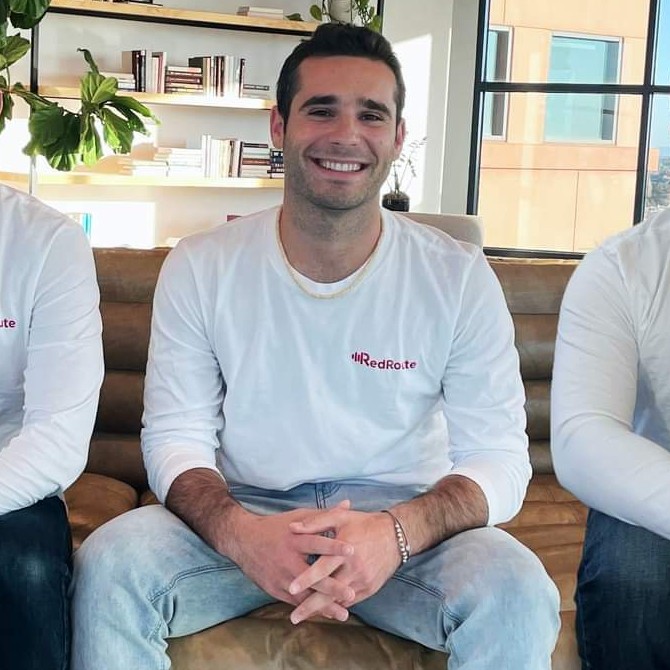
Brian Schiff
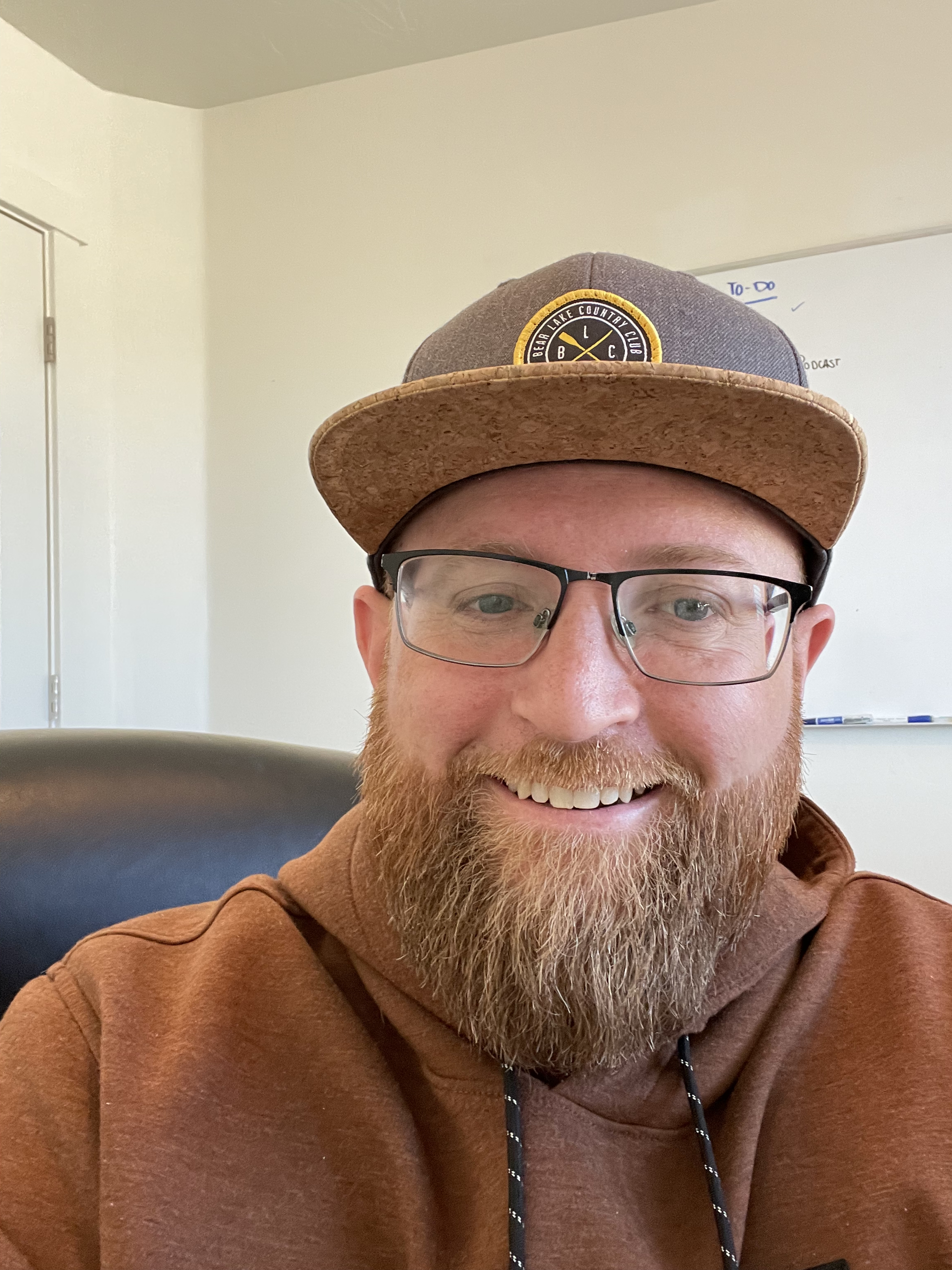
James Gilbert
Today's Guests
